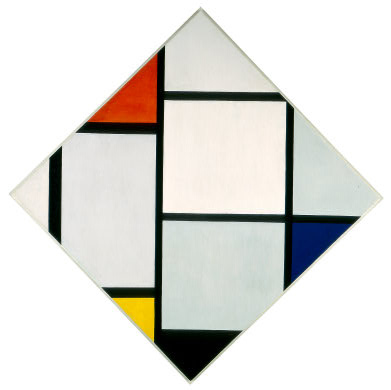Tableau No. IV was created in 1925, a time in which Mondrian was living in post first world war Paris, a time viewed as one of the peaks of Parisian art and culture
Mondrian had himself been moving towards a much more abstract and unique mode of operation, expressing a profound sense of freedom and uncensored creativity in his work. His move from traditional, impressionistic work in his native Holland is capitulated by his move to a newer geometric, abstract and minimalist style represented in Tableau No. IV, a style Mondrian dubbed 'neoplasticism'.
Piet Mondrian's Tableau No. IV Lozenge Composition is one of his most famous works, and is regarded by many as an masterpiece. The work is immediately radical through the lozenge style Mondrian imposes, by purposefully tilting the canvass upon which the work is painted at a forty five degree angle to give it an almost diamond like 'lozenge' shape.
As with many of Mondrian's works, Tableau No. IV is a demonstration of deep held philosophies about the way in which the universe works. Mondrian believed that the universe is fundamentally an interlinked harmonic entity.
The use of clearly defined block colour, dark separating lines and geometric shapes represent the way in which things naturally click together. The universe, just like the squares and lines in Mondrian's piece, is a natural structure of different pieces coming together to form a larger whole. The use of the rotated canvass and diamond like Lozenge shape is equally representative of this worldview.
It is thought that the incomplete rectangles, cut off by the corners of the canvass, demonstrate how the work is only a small piece of a larger whole. The geometric structure of Mondrian's work extends beyond the canvass he is painting on, into a much broader and intricate system. For Mondrian Tableau No. IV is like a window showing only a fraction of something much larger and complex.




